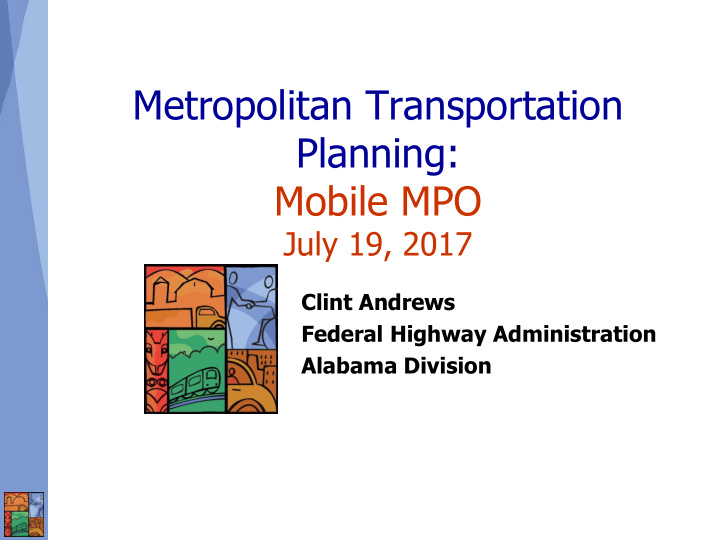



Metropolitan Transportation Planning: Mobile MPO July 19, 2017 Clint Andrews Federal Highway Administration Alabama Division
ANATOMY OF AN MPO A Metropolitan Planning Organization… • Has the authority of Federal law • Is a representative group of local stakeholders • Leads the transportation planning process for the metropolitan area • Is the region’s policymaking organization responsible for prioritizing transportation initiatives • Carries out the metro transportation planning process in cooperation with the State DOT(s) and transit operators 7/19/2017 2
ANATOMY OF AN MPO All “urbanized areas” are required to have an MPO or be part of an MPO 7/19/2017 3
ANATOMY OF AN MPO Urbanized Areas in Alabama 7/19/2017 4
ANATOMY OF AN MPO MPO structure • An MPO is required to have a decisionmaking “policy body” • Beyond this, there is no required structure for an MPO, but most are made up of – A Policy or Executive Board – Technical and Citizen Advisory Committees – A director and staff 7/19/2017 5
ANATOMY OF AN MPO The MPO Board • Takes approval actions • Sets regional long-term transportation policy and approves plans • Prioritizes and programs specific transportation initiatives for funding 7/19/2017 6
ANATOMY OF AN MPO Who sits on the Board? • Required in TMAs/encouraged everywhere: – Local elected officials – Transportation operators – Appropriate State officials • Other possible members: – Representatives from private and not-for- profit sectors – General public Membership should be as diverse as the region 7/19/2017 7
ANATOMY OF AN MPO How does the Board obtain technical analyses? • MPO staff provide committees with technical assessments and evaluations of proposed transportation initiatives • The Technical Advisory Committee provides recommendations to the board on specific strategies or projects • Staff may engage consultants to generate needed data 7/19/2017 8
ANATOMY OF AN MPO How does the Board obtain technical analyses? 7/19/2017 9
How are Projects Selected and what is the Criteria? CONVERT 4- LANE ROAD TO 2 LANES WITH CENTER TURN, SIDEWALKS, AND BIKE LANES ROAD DIET
How do we get a roundabouts? Are there Safety Benefits? 7/19/2017 11
PROCESS AND PRODUCTS Basic requirements • Reflect – The “3C” planning process – The 8 SAFETEA-LU planning factors • Develop – A Unified Planning Work Program (UPWP) or simplified statement of work – Public involvement process/plan (PIP) – Financial Plan • Produce and maintain – A Long-Range Transportation Plan – Transportation Improvement Program (TIP) 7/19/2017 12
PLANNING FOR TRANSPORTATION The Unified Planning Work Program (UPWP) • Planning tasks and studies to be conducted • Any transportation-related air quality planning tasks • All Federally funded studies • State/local planning activities conducted without Federal funds • Funding sources identified for each project • Schedule of activities • Agency responsible for each task or study 7/19/2017 13
PROCESS AND PRODUCTS The Long-Range Transportation Plan • Describes vision for the region, and policies, operational strategies, and projects to achieve it • Covers at least the next 20 years • Contains a financial plan and is fiscally constrained • Is updated every 4-5 years 7/19/2017 14
PROCESS AND PRODUCTS The Transportation Improvement Program (TIP) • A staged, multi-year, intermodal program of prioritized transportation initiatives consistent with Plan • Shows annual activity for a 4-year period • Contains a financial plan and is fiscally constrained • An project not listed in the TIP cannot receive FHWA or FTA funds • Must be updated at least every 4 years 7/19/2017 15
PROCESS AND PRODUCTS TIP/STIP Revisions • TIP Amendments (federal approval) - add, delete, exceeds $, major change, etc. • Administrative Modification (doesn’t require federal approval) - emergency repairs, minor change, etc. • Level of Effort - TAP, safety, recreational trails, resurfacing, transit, etc. 7/19/2017 16
FUNDING AND PROGRAMS Federal Gasoline Tax 0.1 cent 18.4 cents L.U.S.T. Trust Fund 15.44 cents 2.86 cents Highway Account Mass Transit Account Effective October 1, 1997 7/19/2017 17 In cents per gallon
FUNDING AND PROGRAMS Federal Diesel Tax 0.1 cent 24.4 cents L.U.S.T Trust Fund 21.44 cents 2.86 cents Highway Account Mass Transit Account Effective October 1, 1997 7/19/2017 18 In cents per gallon
Strategies to Improve Access and Livability Set Regional Framework - for where and how develop • Growth management, preservation • Regional access management promote designated areas Improve Local Accessibility – jobs, shopping, services, healthcare • Development standards and plans – mixed use • Transportation investments – street connectivity, ped and bike, transit service to focal points Enhance Community Design – • CSS complement natural and built environment • Local access management and design – commercial areas
CONCLUSION Where you can get more information • The Transportation Planning Capacity Building Program – www.planning.dot.gov • FHWA Resource Center – www.fhwa.dot.gov/resourcecenter • FHWA Division Offices – www.fhwa.dot.gov/field.html#fieldsites • FTA Regional Offices – www.fta.dot.gov/about/offices 7/19/2017 20
FEDERAL REQUIREMENTS Federal Highway Administration (FHWA) FHWA has a division office in each state to deliver the Federal-Aid Highway Program to the state DOTs, and to assist the DOTs and MPOs 7/19/2017 21
INFORMATION RESOURCES Thank you R. Clint Andrews, P.E. FHWA – Alabama Division Planning & Program Management Team Leader (334) 274-6346 clint.andrews@dot.gov 7/19/2017 22
Recommend
More recommend